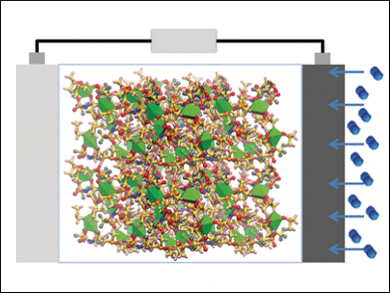Next-Generation Energy Storage
Smartphones, laptops, electric cars – whatever the device, an efficient battery is high on any user’s wish list. The search for the next-generation battery has recently focused on sodium–oxygen batteries. Theoretically, these should provide previously unattainable efficiency but their practical implementation has proven to be a stumbling block. Researchers now report in the journal Angewandte Chemie that a highly concentrated electrolyte solution may make sodium–oxygen batteries more stable, and therefore more practical.
Researchers have high hopes for alkali metal/oxygen batteries since their theoretical energy density is particularly high. In such batteries, one electrode is made from the pure alkali metal. Upon discharging, this electrode gives up electrons to the circuit and positive ions to the electrolyte. The counter electrode is made of porous carbon and is in contact with the air. At this electrode, oxygen is reduced by taking up electrons in the presence of the metal ions. This may result in a variety of metal oxide compounds. As the battery is charged, this process is reversed: Oxygen is released to the air at the positive electrode, while the alkali metal is deposited at the negative electrode.
Viable Sodium–Oxygen Batteries
A number of fundamental problems stand in the way of practical implementation of such systems: insufficient rechargeability; numerous side reactions that limit the stability; and, in trials using lithium, clogging of the porous electrode by lithium peroxide.
Sodium is much easier to obtain and may be a better choice. Sodium–oxygen cells surprisingly do not produce sodium peroxide, instead making mainly sodium superoxide (NaO2), which can be almost reversibly converted back to the elements during charging. The system also requires an anhydrous, aprotic solvent (one that cannot release any H+ ions) for the electrolyte. Dimethylsulfoxide (DMSO) is a good choice for electrochemical applications, but it, unfortunately, reacts with sodium to form products that can be problematic.
High Concentrations for Stable Solvents
Kah Chun Lau, California State University, Northridge, USA, Yiying Wu, Ohio State University, Columbus, USA, and colleagues have found an approach to solving this problem. In their system, a very high concentration of the organic salt sodium trifluoromethanesulfonimide (NaTFSI) stabilizes DMSO in the presence of sodium.
By using Raman spectroscopy of NaTFSI/DMSO electrolyte solutions in conjunction with computational simulations, the scientists were able to explain this effect. Highly concentrated solutions result in a structure of loosely crosslinked Na(DMSO)3TFSI units, which bind a large proportion of the DMSO molecules, leaving only a few available for a reaction. The sodium then preferentially attacks the TFSI anions, which is advantageous because the product forms a passivating protective layer on the sodium electrode.
The researchers built a small battery with this system. It demonstrated good electrochemical properties and underwent 150 charge/discharge cycles without any notable loss of efficiency. In contrast, cells with a dilute electrolyte solution could only last for 6 cycles.
- Concentrated Electrolyte for the Sodium-Oxygen Battery: Solvation Structure and Improved Cycle Life,
Mingfu He, Kah Chun Lau, Xiaodi Ren, Neng Xiao, William D. McCulloch, Larry A. Curtiss, Yiying Wu,
Angew. Chem. Int. Ed. 2016.
DOI: 10.1002/anie.201608607




